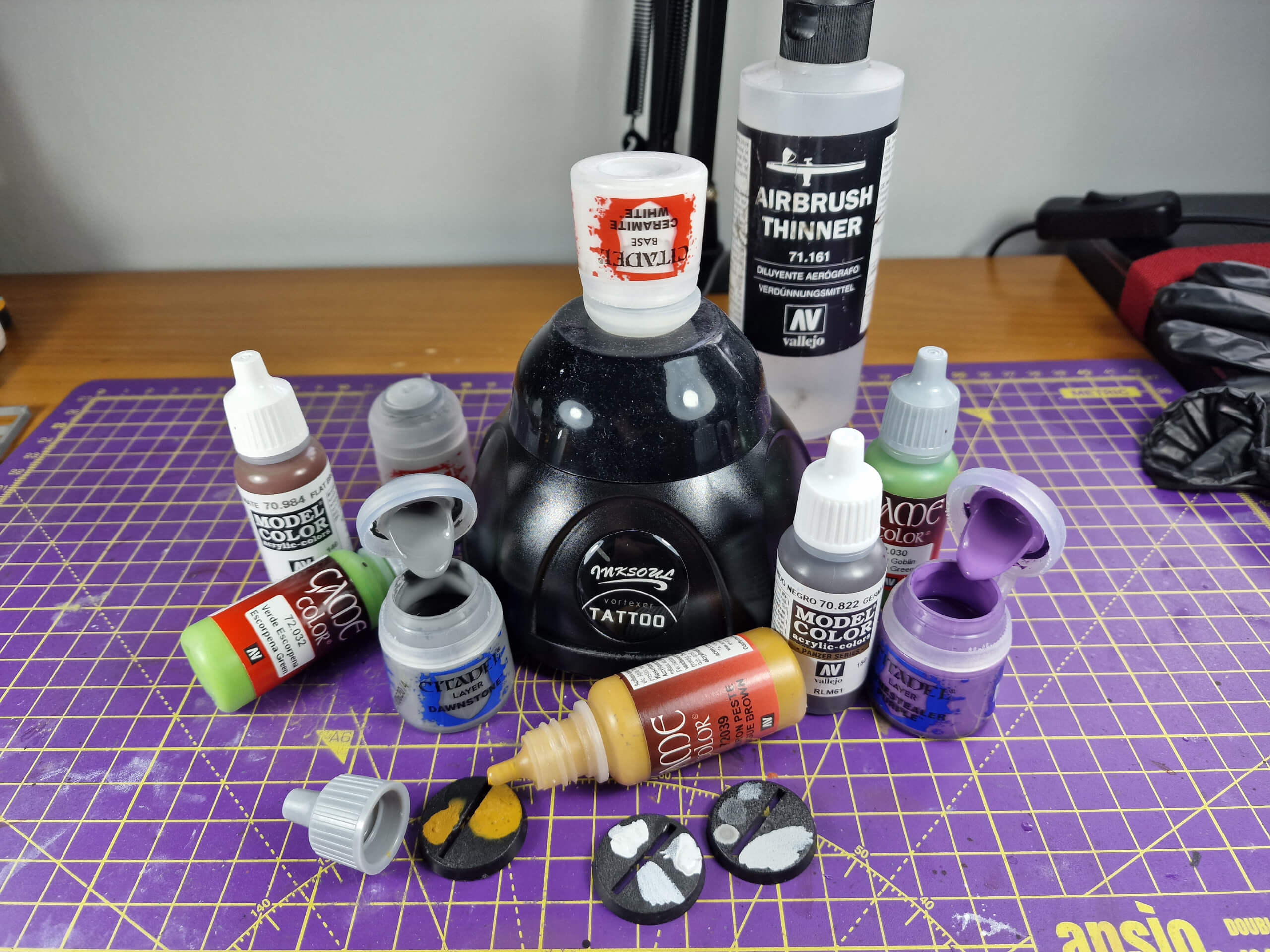A vortex mixer is something that I’ve actually wanted to play with for a while now. I’ve recently been moving my paint and as much of my painting equipment as possible into my new painting desk and whilst doing so discovered that I have rather a lot of paint, and rather a lot of it hasn’t been so much as looked at (never mind mixed!) in quite a long time. Faced with the prospect of trying to shake up a hundred or more bottles of paint by hand I decided that it was finally time to invest in a proper tool for the job!
Are they all this expensive?
A little Googling later and it seemed that everything on the cheaper end of the market was in the £80-100 price range, which my budget simply didn’t allow for. Then I came across this:
It is, as you can see, a ‘tattooing shaker’, or possibly a ‘shading material machine’. It’s clearly a Chinese import: badly-translated English, poor quality printing on the box and a pricing point way below average – this thing was only £30! I’ll post the link to where I found it at the end of the review. If you’re willing to wait a month or so for postage you can find similar looking mixers on AliExpress in the £10-15 range, but I’m impatient and was willing to pay the extra money to have it inside two days.
(I’m hoping that the price of this mixer stays the same across different countries – if it doesn’t then I’m sorry!)
The contents of the box are pretty no-frills. You get the vortex mixer itself and a plug/cable, both rattling around loose. Nothing indulgent, but when you’re on a budget that’s not a bad thing! Much more important is whether or not it actually works!
Alright, here’s the plan!
For the purposes of this test I’ll be trying to remix or revive four paints, shown below:
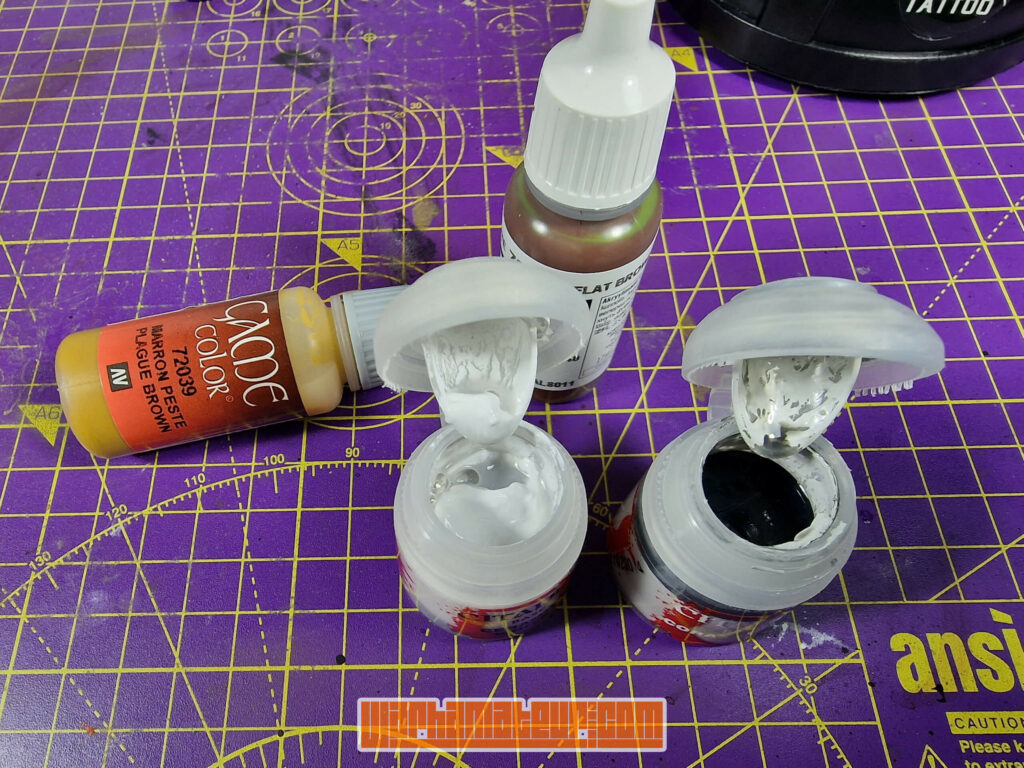
Back row left we have Vallejo Game Color Plague Brown. I’m hoping you can see near the cap that the paint has separated from the medium, leaving a milky white liquid floating around the pigment.
Back row right is a bottle of Vallejo Model Color Flat Brown. In this bottle the actual pigments have separated, leaving green streaks throughout the paint. I’ve actually tried mixing this by hand on a number of occasions with no luck.
Front left is a pot of Citadel Ceramite White, which has gone very lumpy and partially separated from the medium. Given that the paint was discontinued some time ago it’s not surprising!
Front right is a pot of Corax White (another Citadel white?!) that looks like both the pigments and the medium have separated – I certainly wouldn’t expect the medium to be black!
So to test out the new mixer we’re going to give each pot the same treatment and see what the results are at the end. Each pot will be mixed for 20 seconds – 5 the right way up, 5 upside down, repeat both and see where we are. I’ll also be adding two stainless steel mixing balls to the Flat Brown and Corax White to see if that speeds the process up at all. Why two? Because I have 200 of them, and two is probably better than one!
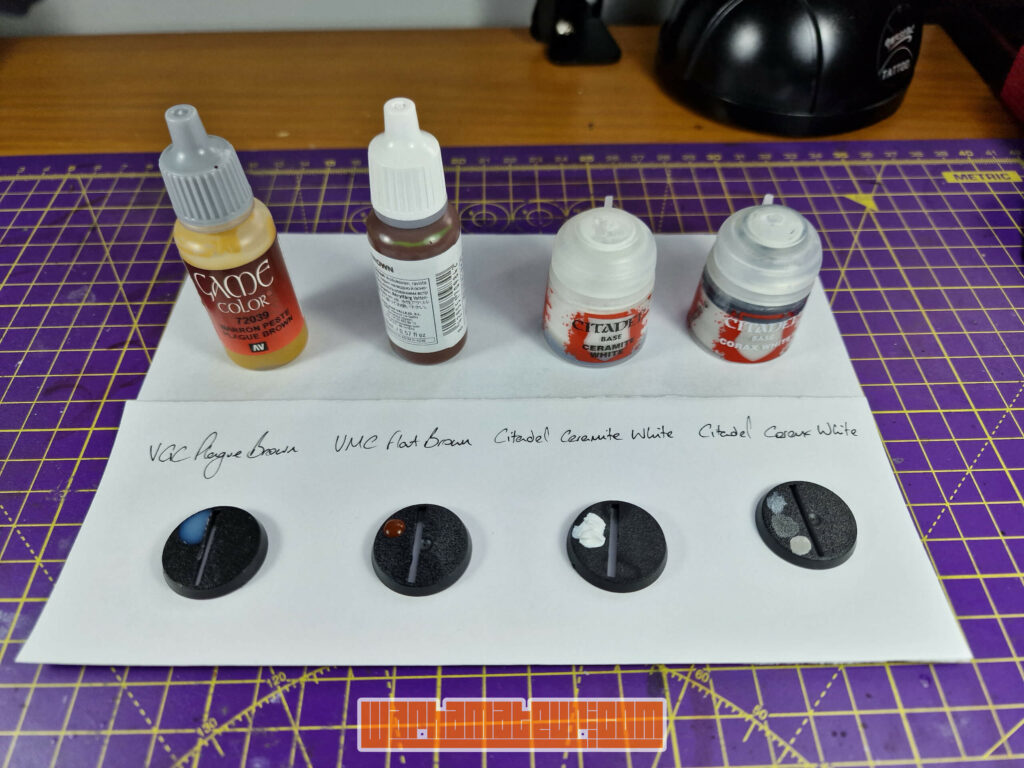
We start here with a little un-shaken paint on each base. Our Plague Brown is nothing but medium, our Flat Brown actually doesn’t look too bad (no hint of green in there!), the Ceramite white is very lumpy, and I had to dig right to the bottom of the pot to get ‘Corax Grey’. To give you an idea of how thick this paint has become here’s a photo of two agitators sat on the top of it!
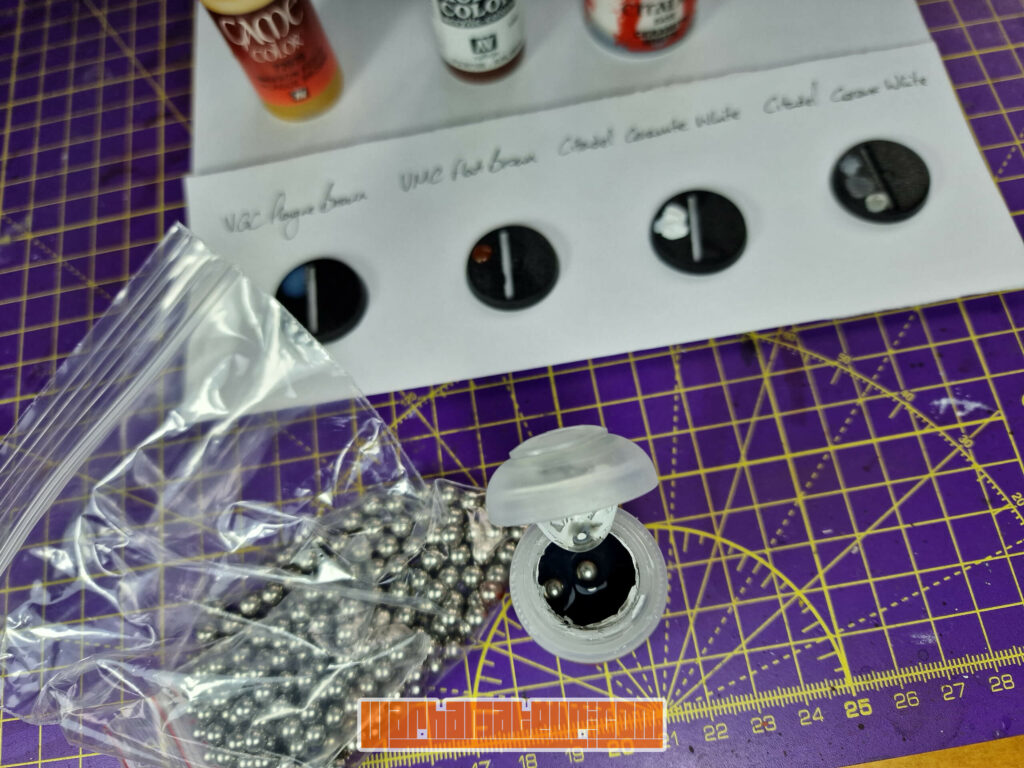
Execution!
Each pot or bottle now gets ~20 seconds of mixing, with varying results shown below.
The Plague Brown has mixed back together, but is very thin – enough so that when I went to put a drop on the base it flowed everywhere!
The Flat Brown now has a consistent colour in the bottle, but the paint itself remains pretty much unchanged. In hindsight this maybe wasn’t the best paint to test!
The Ceramite White has mixed in a little but it’s still very lumpy.
The Corax White remains pretty much unchanged – you’ll notice I didn’t bother to take another sample from it.
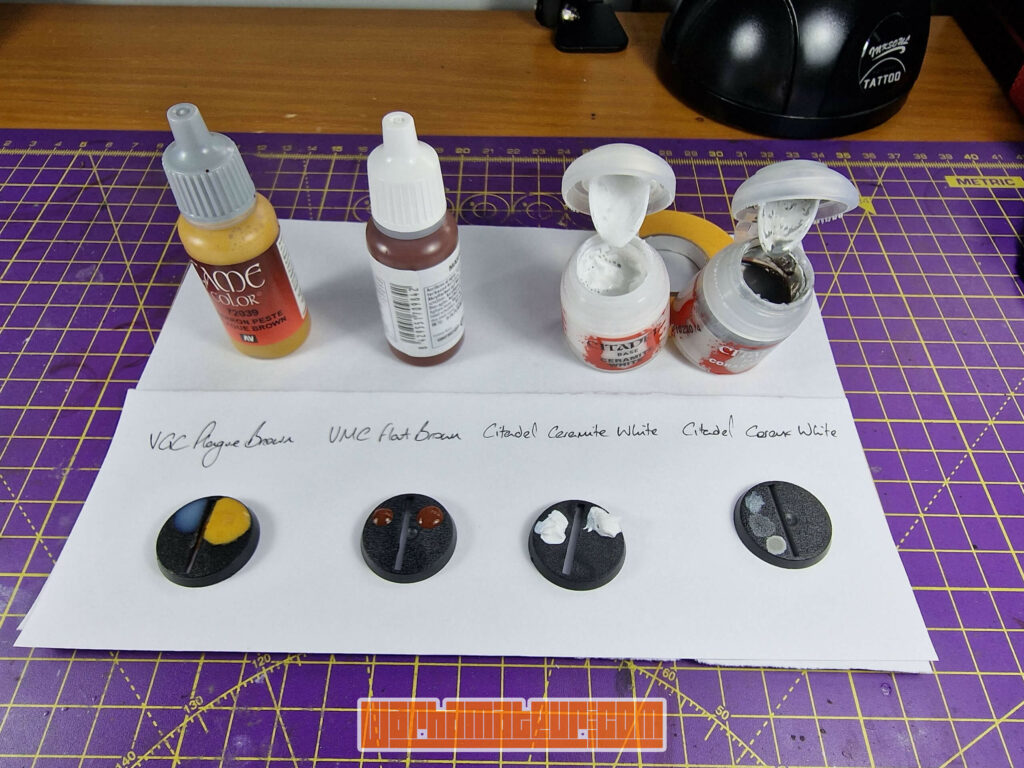
Perhaps I’m simply not mixing for long enough? I added agitators to the Ceramite White and a few drops of Vallejo Airbrush Thinner to both Citadel pots, and went back to the vortex mixer, this time simply mixing until I got bored of waiting. The Plague Brown only had maybe 30 seconds, the Flat Brown less, and both the Citadel pots got at least a minute.
The results this time? The Plague Brown did thicken up a touch, but I have a feeling that this paint is always going to be on the thin side no matter what I do to it.
The Flat Brown was again fairly unchanged.
The Ceramite White is still lumpy but I was able to get a fairly smooth result on the brush. If I was desperate to use an OOP paint then I could keep going until the pigment mixed fully.
The Corax White was able to provide a fairly smooth grey colour from the brush, but the paint itself is still rather lumpy.
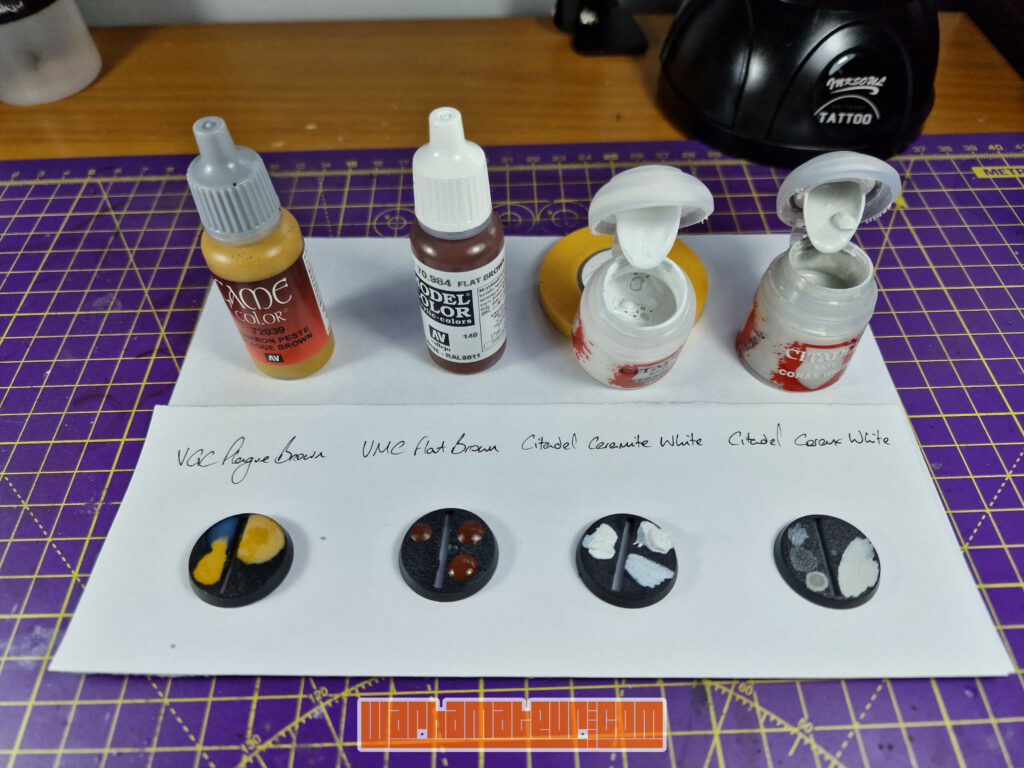
Maybe I’m asking a little bit too much of the mixer in too short a space of time? Two of these paints are old Citadel whites, which are renowned for being chalky and difficult to work with. I went back to my paint drawers and found some new test subjects, pictured below.
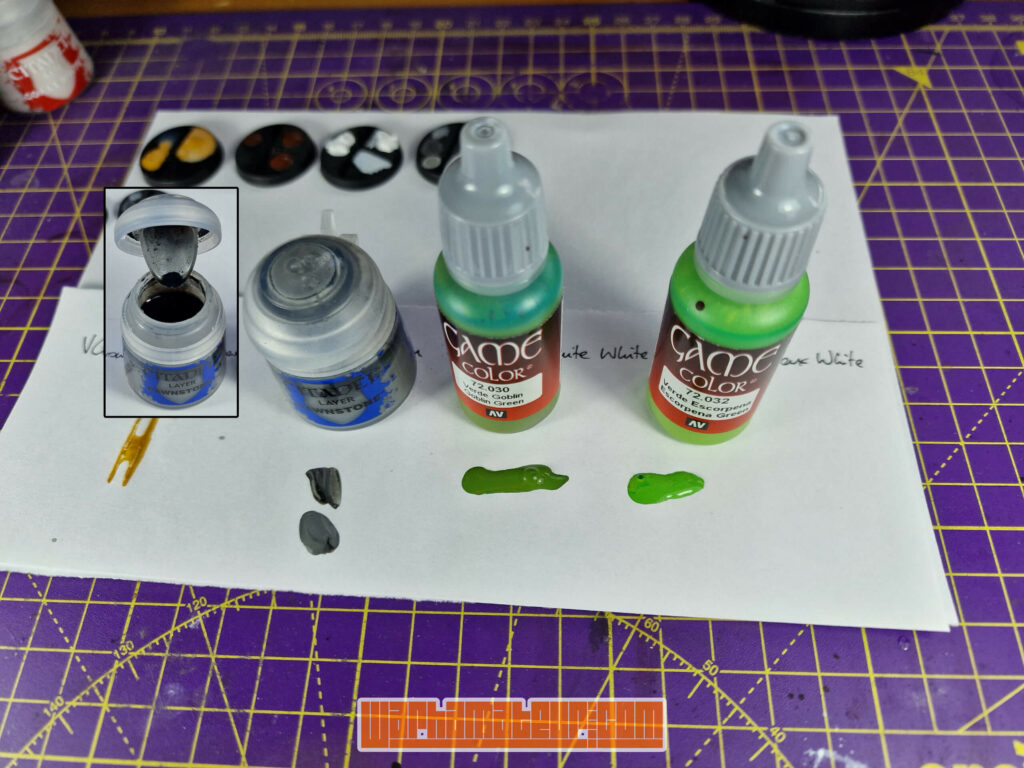
We have Citadel Dawnstone with a black separated medium (I forgot to open the lid so added it in from another before shot, sorry!), VGC Goblin Green with pigment separation (it doesn’t show up well in the sample because I’m not a photographer, but the line of paint does have some yellow running through it) and VGC Escorpena Green, which also has some pigment separation.
Agitators for all and a couple of drops of thinner for the Dawnstone, followed by 30-60 seconds mixing for each gives us this result: smooth all round!
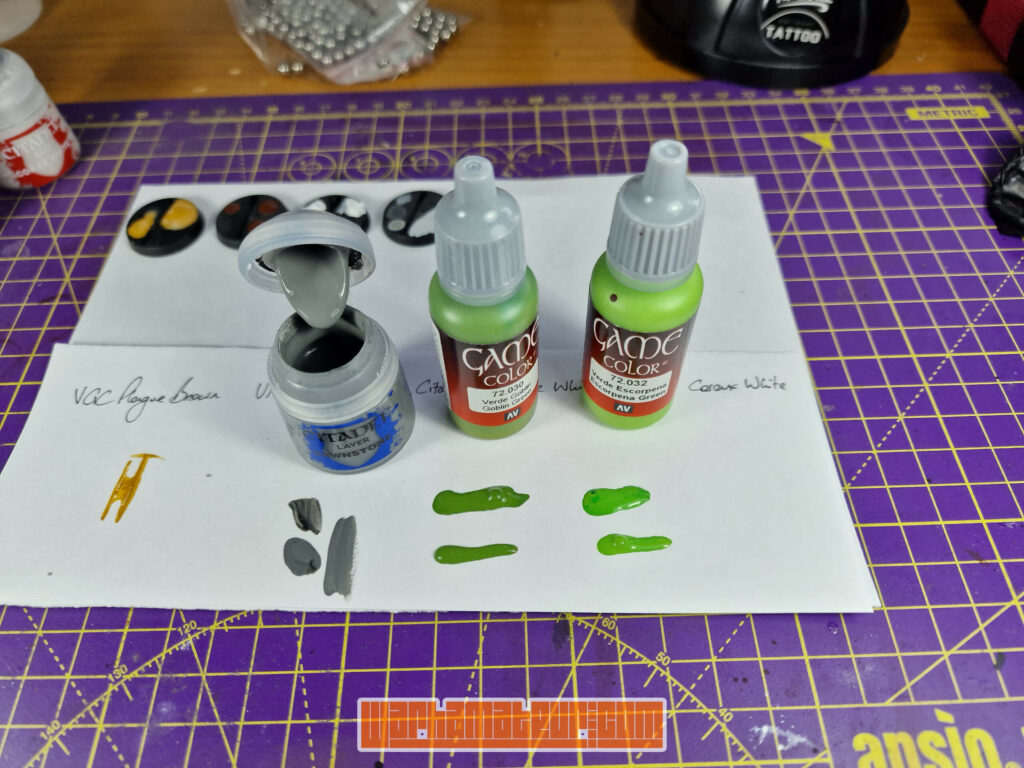
A pot of Genestealer Purple was my final test – again lumpy and separated before:
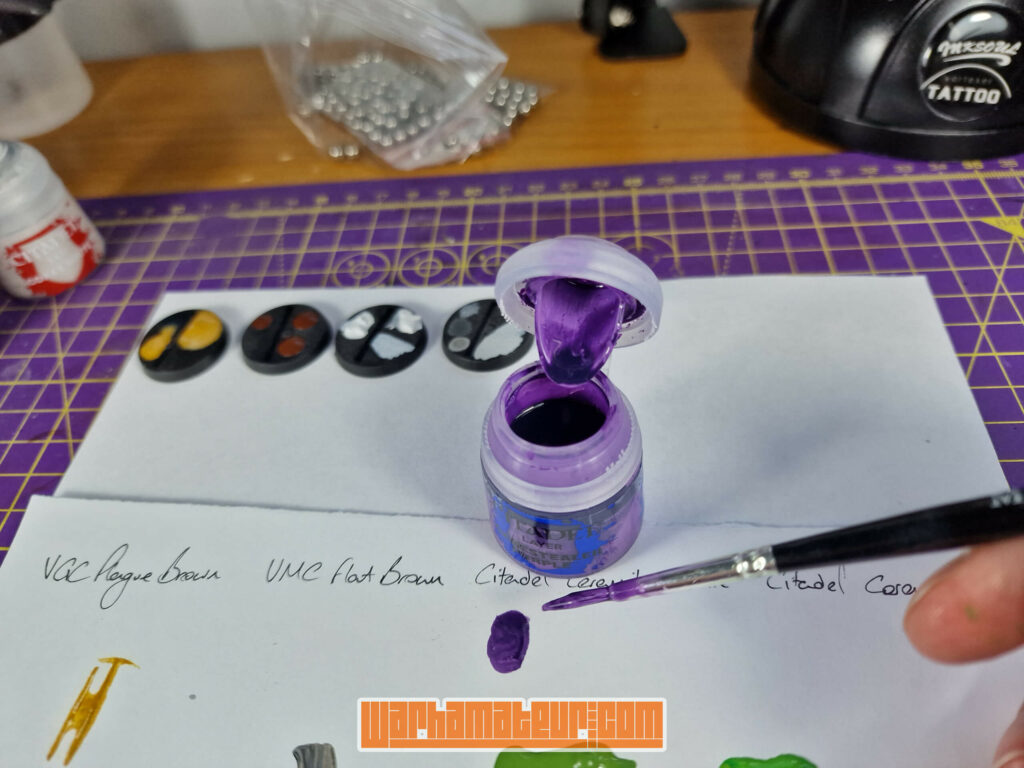
But with agitators, a drop of thinner and a quick blitz we again have creamy smooth results!
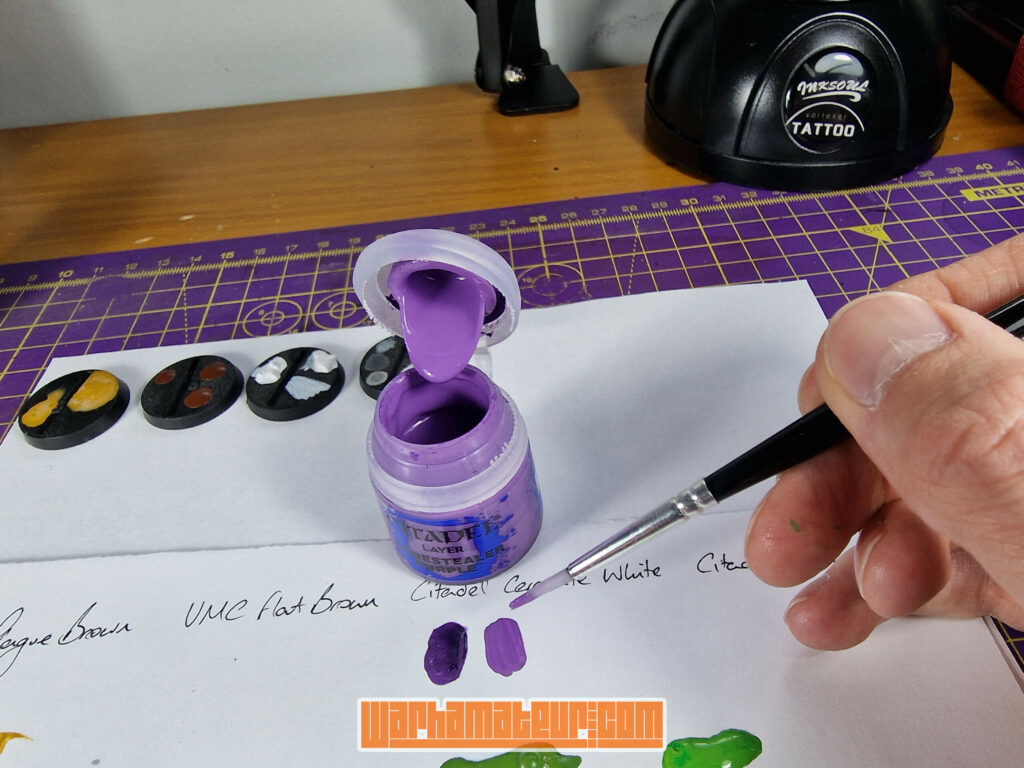
So, did it work?
Well, yes! Some of my results weren’t perfect, granted, but I’m putting this down to very old paint and me simply giving up too early. I’m confident that if I really wanted those pots reviving then with a little more work I could get it done.
The rest however did pretty much what I asked of them – pigments and mediums were mixed back into the paints, and everything came out smooth in the end.
The minor details
Waking the neighbours
This thing vibrates. Like quite a lot. Before testing for this post I actually had a very quick play with the mixer using a (very pigment-separated) bottle of VMC German Camo Black Brown. At the same time I was also playing with the swing-arm mount for my phone, which resulted in this rather wobbly footage.
If you’re going to use one of these I would maybe suggest trying to find a way to dampen the vibrations a little. This thing makes significantly more noise downstairs than my airbrush compressor does, and the compressor sits directly on the floor upstairs. I’m thinking I might try sticking it to the windowsill when I’m using it, as I’m fairly certain the walls will carry the vibrations a little less than a wooden table!
You might also want to keep hold of it with your free hand – it helps stop the vibrations a tiny bit, but it also stops it from vibrating its way across your desk!
My fingers have stopped working!
Actually that’s not entirely true, they haven’t stopped working. At all. They might do though!
Hyperbole aside, there is a tiny bit of genuine concern here. There is the possibility that with prolonged use you might start to encounter the effects of ‘vibration white finger’, though I can’t say for definite what counts as ‘prolonged’. I would be very surprised to find that proper tests had been done on a generic Chinese mixer, but I was able to find this pdf for another mixer. Whether any comparisons can be drawn between the two I don’t know, but it looks like you’ll be okay so long as you don’t try to mix your entire paint collection on a daily basis!
Sticking to mixing each pot/bottle as and when you use it should be perfectly fine, but for legal purposes I will point out that I am neither a doctor nor any other kind of authority on the matter!
You’ve gotta hit the right spot!
This one really only is minor, but I found that the mixer was rather pedantic when it came to positioning. If I didn’t have the pot/bottle in exactly the right spot then the speed of the mixer would fluctuate until I got it right, at which point it would jump up to full power. I don’t know if this is normal or not, but it’s something to bear in mind.
The final debrief
All in all I think this was a fairly solid purchase. I obviously can’t compare it to more expensive mixers, but if they are more efficient then I can only imagine this comes at the cost of increased vibration and noise, which isn’t a trade-off I would be willing to make.
The vortex mixer itself costs about the same as 10-12 bottles of paint (with an FLGS discount), but saves you the work of hand-mixing paints. For those you regularly use this is may be only a quick shake but I had long ago given up on trying to mix two of the Vallejo bottles that I’ve shown above, and this thing got the job done! It also revitalised two old Citadel pots, and while two weren’t completely finished I’m sure that if I committed myself to the task I could get it done.
For speed, efficiency and overall results I think that the price is most definitely worth it. And I’m sure that in time my elbow and wrist will come to thank me!
There are of course plenty of examples of people using Orky solutions involving power tools and gaffer tape to achieve the same goal. A partially-disassembled jigsaw nailed to some clamps might do the job just as well, but for £30 this thing is pretty affordable, pretty small, and doesn’t require old power tools from the garage!
Equipment list
The vortex mixer
I bought my vortex mixer from a store called Hobby Heaven in the UK – you can find a direct link to it here. Alternatively for the Amazon Prime crowd or those not from the UK you can get what looks to be the same generic mixer from here for about £30 – you’ve gotta love saving with free postage! (those outside the UK may have to check the ‘similar products’ box if the match or price isn’t perfect). If you’re willing to wait for delivery then you could also try here and save some money – this is likely where the Amazon sellers are getting theirs!
Agitators / mixing balls
You would think that any kind of steel ball bearing-type object would do, but there are many kinds of steel that will rust if you leave them in your paint, and that’s not what you want!
There are plenty of places that you can buy branded agitators but I find it’s easiest to simply buy them in bulk from Amazon. There’s loads of listings at around the same price, so you don’t have to worry too much about brand or seller, so long as you know that nothing is going to rust! This one will do the job perfectly well!


